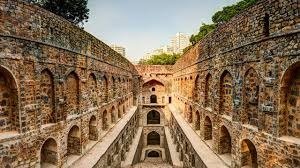
Baolis, or stepwells, hold a revered place in India’s architectural heritage. Beyond their practical function as water reservoirs, these marvels served as social hubs for gatherings, gossip, and a refuge for weary travelers in medieval times. Among these historical wonders stands the enigmatic Agrasen ki Baoli, nestled in the heart of Delhi. This ancient stepwell, located on Hailey Road, is a masterpiece of architecture that invites visitors to delve into its rich history and enduring legends.
A Glimpse into History
Dating back to the 14th century, Agrasen ki Baoli is believed to be a testament to Delhi’s deep-rooted heritage. Its exact origins remain a mystery, but local lore attributes its creation to King Agrasen, the legendary forefather of the prosperous Agrawal community. Another tale suggests that it dates back to the Mahabharata era, adding a mythical layer to its already intriguing history.
The structure was likely repaired during the Tughlaq or Lodi eras, reflecting a shift in architectural style. Spanning 60 meters long and 15 meters wide, with 108 meticulously crafted steps, this stepwell exemplifies the brilliance of medieval water management systems.
Legends and Hauntings
The depths of Agrasen ki Baoli are cloaked in folklore and ghostly tales. Some legends claim that the waters once possessed supernatural powers, luring unsuspecting souls to their doom. It is said that those who gazed into its black waters fell into a trance and jumped to certain death. While the waters have long dried up, these eerie stories continue to intrigue visitors.
Despite its haunted reputation, there is no concrete evidence to confirm paranormal activity. Instead, the baoli stands as a monument to architectural ingenuity and the mysteries of time.
A Photographer’s Paradise
Agrasen ki Baoli has been featured in numerous Indian films and is a popular spot for photography enthusiasts. Its intricate arches, ornate carvings, and the play of light and shadow create endless opportunities for capturing unique shots. Whether it is the symmetry of the steps or the serenity of the ambiance, the baoli offers an ideal backdrop for photographers and history buffs alike.
Architectural Marvel and Cultural Legacy
Descending into Agrasen ki Baoli feels like stepping into a bygone era. The arched niches, inner chambers, and narrow passages reflect a fusion of architecture and history. A small tunnel, waist-high, runs through the back wall of the baoli, adding an element of intrigue.
At the top of the baoli stands a half-broken mosque with two unique features. The first is its whale-back roof with slightly arched slopes, an uncommon feature for mosques. The second is its red-coloured pillars adorned with Buddhist motifs at the base, hinting at cultural exchanges from a bygone era. These details offer a captivating glimpse into Delhi’s diverse heritage.
A Protected Monument
Today, Agrasen ki Baoli is a protected monument under the Archaeological Survey of India. Its preservation ensures that future generations can marvel at its architectural brilliance and unravel its mysteries. As visitors continue to flock to this historical site, the baoli remains a powerful reminder of India’s rich cultural tapestry.
More Than Just a Stepwell
Agrasen ki Baoli is more than just a water reservoir; it is a journey through history, a canvas for architectural excellence, and a window into India’s vibrant past. Whether you are a history enthusiast, a photographer, or simply a curious traveler, a visit to this ancient stepwell promises an experience steeped in culture, mystery, and awe.
Don’t miss the chance to explore this timeless marvel in the heart of Delhi!

